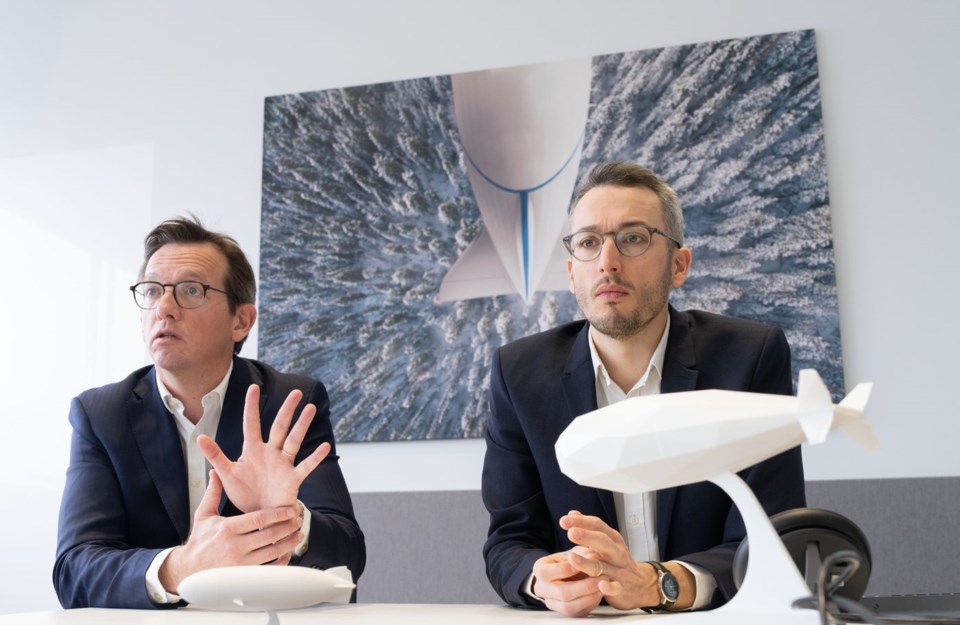MONTREAL — From the seventh floor of his Montreal office, Arnaud Thioulouse enjoys a view of the midtown rail tracks and freight trains chugging toward the horizon. But the CEO of Flying Whales Quebec has a different transportation mode in mind for ferrying goods to far-flung locales: airships.
“The question is not if there will be such a craft in the air, but when,” he said.
Thioulouse is part of a bevy of engineers, academics and investors across the globe pouring time and hundreds of millions of dollars into creating aircraft far more advanced than an old-fashioned zeppelin or the Goodyear blimp, which turns 100 this year, putting Canada on the front line.
With their low emissions and high carrying capacity, these hovering behemoths have the potential to bring essential goods and medical care to northern communities, serve remote mines or forestry operations and conduct military patrols, all at relatively low cost and minimal environmental impact — if financing and technical hurdles can be overcome.
In 2023, Flying Whales signed a non-binding deal with the Inuit-owned Canadian North airline to study airships’ potential to haul cargo above the 60th parallel. Quebec has invested $77 million into the company, which set up in Canada in 2022.
The company hopes to run initial test flights in late 2027 and its first commercial forays in 2029.
In a twist on their cigar-shaped predecessors, modern airships tend to more closely resemble massive, floating rugby balls. Filled with helium or hydrogen, the main body can be either a balloon or a fabric-wrapped metal frame — or something in between — driven by engine-powered propellers and fin-like rudders.
With a half-billion-dollar budget, Flying Whales’ 200-metre-long hybrid-electric helium airship — now in the final design phase — promises a range of 1,000 kilometres. It would burn little fuel, carry 60 tonnes of payload and take off and either land vertically or not at all, instead hovering in the air while winches load and unload cargo like a crane, says the parent company’s chief executive Vincent Guibout.
Heather Exner-Pirot, director of energy, natural resources and environment at the Macdonald-Laurier Institute, pointed to melting ice roads and sheer distance as impediments to getting items such as perishable food, septic tanks and housing materials to Canada's North.
“It’s just very hard to plan and very expensive to implement any kind of construction. You’re talking about a new hospital, a new school, even a new Norad base,” she said.
Lighter-than-air aircraft could offer a convenient halfway point between ocean freighters — round trips between Montreal and Iqaluit can take several weeks — and fast but expensive planes.
With a cruising speed of up to 100 km/h, Flying Whales hopes to provide a supplement to current transport methods.
Resource development is another target, with airships able to haul industrial parts, wind turbine blades, transmission towers and critical minerals.
“We’d love to be a use case to demonstrate how effective this technology can be for mining,” said Christine Burow, chief marketing officer for Torngat Metals, a Quebec-based junior mining developer seeking a half-dozen airships. The company’s focus is rare earth elements needed for the permanent magnets common in electric vehicle motors.
While unfit for bulkier extractions like iron ore, airships are ideal for shuttling lower-weight commodities such as rare earth metals, gold and diamonds.
Before the start of a new golden age for airships, however, several hurdles must be cleared — not least the cultural memory of the Hindenburg disaster, which saw the commercial zeppelin burst into flames in 1937, killing 36 people and shattering public confidence in the aircraft.
“Governments are notoriously difficult to engage with because they just remember the Hindenburg,” said Alan Shrimpton, who heads the U.K.-based Airship Association.
In Canada, a ban on “lifting gas” — due to hydrogen's flammability when mixed with air — also hampers development, said Barry Prentice, who heads the University of Manitoba’s Transport Institute. Helium is up to 70 times more expensive than hydrogen, and the price is volatile.
Cash remains a broader concern, given airships’ uncertain horizon.
“Financing is always the challenge,” said Igor Pasternak, founder of Aeros, an American maker of surveillance airships.
Technological challenges linger, too.
Airships need what’s called variable buoyancy — being able to compensate for weight changes when cargo is picked up or unloaded.
Simply venting the lifting gas would require stockpiles at all destinations, making it a costly and logistically tough option. And strong winds can hinder or halt flights.
One solution lies in compressing the gas inside the balloon and filling the remaining space with water or pressurized air from outside. Flying Whales aims to adopt this method, though for now it relies on water ballast.
Potential applications abound if those obstacles can be cleared, including for health, national security, disaster relief and luxury tourism.
Flying Whales hatched plans for a “modular hospital" that would fit into its cargo bay. Touching down for weeks at a time, the prefab clinic could offer ultrasounds, eye care and even surgery for northern communities in dire need of medical services, its CEO said.
In Canada, Flying Whales has now secured more than 70 pre-commercial agreements, with partners ranging from Pratt & Whitney Canada to Honeywell Aerospace, Thales Canada and Delastek. Respectively, the latter three are designing the generators, flight control systems and the gondolas below the balloon to house the crew.
It plans to expand its 30-plus team in Montreal to 300 more working on an assembly line planned for one of two sites in Quebec — near either Sherbrooke or Trois-Rivières. Another factory location has been staked out in Bordeaux, France.
With possible airships waiting in the wings in several countries, Prentice pointed to Canada as an ideal market because of its scattered population, sprawling land mass and vast natural resources.
“Canada has more to gain from an airship industry than any of them,” he said.
This report by The Canadian Press was first published Feb. 16, 2025.
Christopher Reynolds, The Canadian Press



